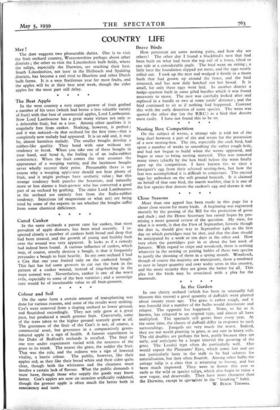Colour and Soil On the same farm a certain amount
of transplanting was done for various reasons, and some of the results were striking. Cox's were removed from a sloping orchard to lower ground, and flourished exceedingly. They not only grew at a great pace, but produced a much greener fruit. Conversely, some of the trees taken to the higher ground scarcely grew at all. The greenness of the fruit of the Cox's is not, of course, a commercial asset, but greenness in a comparatively green- natured apple is a sign of health. A famous experiment in the Duke of Bedford's orchards is recalled. The fruit of one tree under experiment varied with the nearness of the grass to its trunk. The nearer the grass, the redder the fruit. That was the rule, and the redness was a sign of lowered vitality, a hectic colour. The public, however, like their apples red, as they like their bread white and their cider quite clear, though both the whiteness and the clearness must involve a certain lack of flavour. What the public demands it must have, though those who supply the goods may know better. Cox's apples are now on occasion artificially reddened, though the greener apple is then much the better both in consistency and taste.














































 Previous page
Previous page